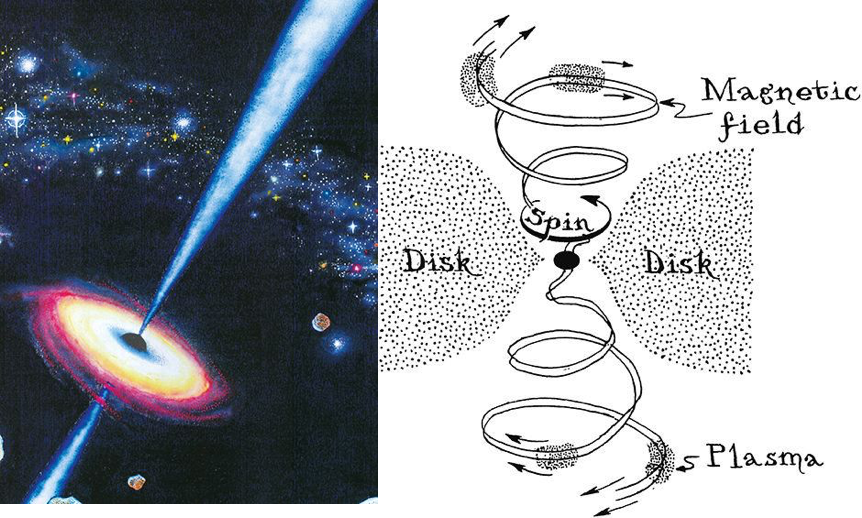中国西南天文研究所深入研究黑洞自旋能量提取的天体物理过程
The astrophysics of extracting spin energy from a black hole
北京时间11月13日凌晨,国际科学期刊《自然·天文学》(Nature Astronomy)在线发布了美国州立肯内索大学大卫·加罗法洛博士和云南大学中国西南天文研究所钱德拉·巴哈杜尔·辛格博士题为《黑洞自旋能量提取的天体物理过程》文章(http://dx.doi.org/10.1038/s41550-021-01527-5)。
黑洞是一种质量范围从几倍到几十亿倍太阳质量的致密天体。它们可以引发宇宙中最剧烈的活动现象,其能量来自于物质自由下落的引力势能和黑洞自旋能量。Blandford 和 Znajek 于1977 年发表了一篇关于黑洞的经典文章,在该文章中他们提出黑洞视界上的磁场能够提取黑洞自旋能量,并导致非常强的准直外流,即喷流。
今年9月,两位英国著名天体物理学家King 和 Pringle在《天体物理学》期刊上发表论文,声称黑洞自旋能量的提取可能不适用于黑洞周围的电导率无限大的等离子体。在上引近期发表在Nature Astronomy上的工作中,加罗法洛博士和辛格博士重新审视了该问题并指出通过正确处理黑洞周围弯曲时空中的天体物理学过程该问题能够得到妥善解决。在讨论旋转黑洞附近的电磁性质时,我们需要考虑更为真实的物理条件,比如有限的电导率过程。该项工作同时表明,在强引力场中等离子体的特性得到全面理解前,任何旨在否定黑洞自旋能量提取的尝试都是没有意义的。
钱德拉·巴哈杜尔·辛格博士为云南大学中国西南天文研究所的副研究员,是本文的共同通讯作者。这篇工作的另一通讯作者是美国州立肯内索大学副教授大卫·加罗法洛博士。《自然·天文学》是《自然》杂志旗下,一份致力于发表天文学、天体物理学、宇宙学和行星科学前沿研究的期刊。

图1: 左图为黑洞周围吸积盘喷流系统的艺术图,右图为通过磁场提取黑洞自旋能量形成喷流的示意图(图片取自《星际科学》一书)。Figure 1: An artistic impression of an accretion disk-jet system around a black hole on the left panel and a cartoon diagram showing the extraction process of black hole spin energy by magnetic field for jet formation on the right panel (Images taken from the book: The Science of Interstellar).

On November 13, 2021, Dr. David Garofalo from Kennesaw State University and Dr. Chandra Bahadur Singh from SWIFAR-YNU published an article titled “The astrophysics of the rotational energy extraction from a black hole” in Nature Astronomy (http://dx.doi.org/10.1038/s41550-021-01527-5).
Black holes are compact objects with masses in the range of a few to several billion solar masses. They are responsible for some of the most energetic phenomena in the universe. The energy comes from the gravitational potential energy of the in-falling matter and the rotational energy of the black holes. A highly cited piece of classical work on this topic was published in 1977 by Blandford & Znajek with regard to the extraction of spin energy that leads to very powerful and collimated outflows called jets as a result of the magnetic fields anchored on the horizon of a black hole.
This year, a paper by two world-leading British astrophysicists King & Pringle appeared in the Astrophysical Journal in September. They claimed that extraction of black hole spin energy might not be working for infinitely conducting plasma around the black hole. In the aforementioned Nature Astronomy article, Garofalo & Singh revisited the issue by appropriately treating the astrophysics in curved spacetime around black holes. To assess the electrical properties near rotating black holes, one must implement more realistic physics like finite conductivity. A full exploration of plasma properties is due so until then, any attempt to invalidate the extraction of black hole spin energy is moot.
Chandra Bahadur Singh, Associate Research Professor at SWIFAR-YNU, is one of the corresponding authors. David Garofalo, Associate Professor at Kennesaw State University, USA is the first author of the paper. Nature Astronomy is a Nature journal dedicated to presenting the very best research across the disciplines of astronomy, astrophysics, cosmology, and planetary science.
